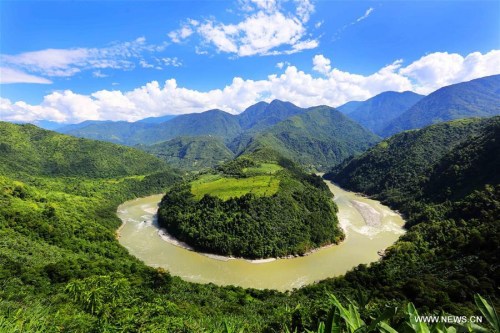
File photo taken on Dec. 6, 2014 shows the big turn of Yarlung Zangbo River in Medog County, Nyingchi City, southwest China's Tibet Autonomous Region. (Xinhua/Liu Fengying)
The Tibetan plateau remains one of the world's cleanest regions despite the lingering presence of pollutants from farming and mining, according to research released on Wednesday.
The pollutant levels recorded on the plateau are similar to those seen across the Arctic, and remain remarkably lower than densely-populated areas, according to the environment change evaluation report, which was organized by the Institute of Tibetan Plateau Research under the Chinese Academy of Sciences (CAS) and featured research from scientists from across the world.
The report warned, however, that should the average global temperature continue to rise over the next 100 years, and hit 4 degrees Celsius higher than preindustrial levels in the next 100 years; the worse case scenario predicted by some scientists, 81 percent of the permafrost on the Tibetan plateau will have disappeared by 2100.
Airborne pollutants on the plateau have increased by 200 percent since the 1950s, it said. However, both black carbon, a climate forcing agent that heats the atmosphere and warms the earth, and persistent organic pollutants remain at a relatively low level, which is close to or lower than in the Arctic or the Alps.
While the report paints a mixed picture of one of the world's cleanest regions, the authors remained upbeat that as long as positive human intervention continued the low-environment background value of the region could be maintained.
A WARMER "ROOF OF THE WORLD"
The average annual temperature of the region rose by 0.3-0.4 degrees Celsius every decade from 1960 to 2012, about twice the world average, resulting in retreating glaciers and disappearing permafrost.
High-altitude areas are more vulnerable to global warming, so it is not unusual that temperatures on the Tibetan plateau rose faster than the global average, said Xu Baiqing, a researcher with the institute.
"Glacier shrinkage is not unique to the Tibetan plateau, but a common crisis all plateaus are facing, thanks to global warming," Xu said. "Glaciers are melting even faster in the Alps, Andes and Kilimanjaro."
The report warned of the cost of loss of wetlands and accelerating desertification, but assured that "the Tibetan plateau's ecosystem is improving overall." Improvements include the boundaries of frigid and sub-frigid zones moving westward and northward, the temperate zone expanding, and the area covered by arctic-alpine steppe increasing.
THE ROLE OF HUMANS
The report acknowledged the negative impact of human activities, such as farming, grazing, mining and urbanization, on the plateau's environment.


















































